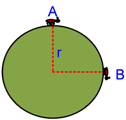Accelerated Motion Common Problems
- Category: High School
- Written by fisikastudycenter
Fisikastudycenter.com- The Examples of High School Physics Problems and Solutions for Grade 10, Motion along Straight Line : Constant Velocity, Uniform Accelerated Motion.
![]()
Problem 1
A stone of 200 g throw up with 50 m/sec of initial velocity.

Ignore the air friction and use the acceleration due to gravity g = 10 m/sec2, find :
a) The maximum height of stone
b) Time taken to reach the maximum height
c) Time taken by the stone before reaching the ground.
Solution
a) The stone velocity = 0 m/sec, in it's maximum height. Using accelerated motion formula:

b) The time taken:

c) Time for the stone in the air:
t = (2)(5) = 10 sec
Problem 2
A car moves at speed of 72 km/hrs, before the breaks works and finally stops at 8 m after the break works. Find the acceleration of the car!
Solution
First, convert the unit of speed from km/hrs to m/sec.Using the formula:

Problem 3
Given a graph shown below: 
Find:
a. distance for t = 5 sec till t = 10 sec
b. the displacement for t = 5 sec till t = 10 sec
Solution
Finding the distance when given a graph of V (speed) - t (time) : Calculate the area of V-t graph (under the lines till t axis), all area is positif value, for calculating the distance, above the t axis also under t axis. For calculating the distance, use the same methode, but the above t axis area is positif, under the t axis is negative value, 
Problem 4
An ant moves from point A to point B as shown below. 
The radius of circle is r = 2m, and the ant need 10 sec to reach point B.Find:
a) The average velocity
b) The average speed
Solution
We have to calculate the distance and displacement of the ant first:
Distance = 1/4 (2πr) = 1/4 (2π x 2) = π m
Displacement, use phytagorean:
Displacement = √ ( 22 + 22 ) = 2√2 meter.
a) Average velocity = displacement : time
Average velocity = 2√2 meter : 10 sec = 0,2√2 m/sec
b) Average speed = distance : time
Average speed = π meter : 10 sec = 0,1 π m/sec
Problem 5
An airplane moves from P to Q at the east direction for 30 minutes with constant velocity of 200 km/hrs. From Q the plane moves to R that located 53o from east direction an need 1 hr flaying with constant average of 100 km/hr. 
Find:
a) The average velocity of the plane
b) The average speed of the plane
Solution
First, find the length of PQ, QR, QR', RR', PR' and PR 
PQ = VPQ x tPQ = (200 km/jam) x (0,5) jam = 100 km
QR = VQR x tQR = (100 km/jam) x (1 jam) = 100 km
QR' = QR cos 53o = (100 km) x (0,6) = 60 km
RR' = QR sin 53o = (100 km) x (0,8) = 80 km
PR' = PQ + QR' = 100 + 60 = 160 km
PR = √[ (PR' )2 + (RR')2 ]
PR = √[ (160 )2 + (80)2 ] = √(32000) = 80√5 km
the distance = PQ + QR = 100 +100 = 200 km
the displacement = PR = 80√5 km
the time taken = 1 hr + 0,5 hr = 1,5 hrs
a) The average velocity = displacement : time taken = 80√5 km : 1,5 hr = 53,3 √5 km/hr
b) average speed = distance : time taken = 200 km : 1,5 hr = 133,3 km/hr